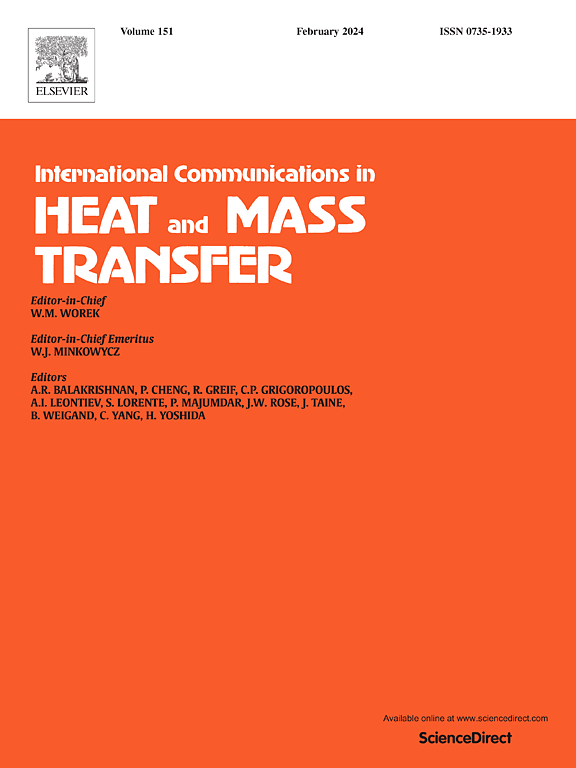Interfacial thermal conductance at the gas-solid interface: microscopic energy transport mechanisms and the thermal rectification phenomenon
IF 6.4
2区 工程技术
Q1 MECHANICS
International Communications in Heat and Mass Transfer
Pub Date : 2025-05-30
DOI:10.1016/j.icheatmasstransfer.2025.109153
引用次数: 0
Abstract
The thermal conductance across gas-solid interfaces is the primary pathway for thermal dissipation in low thermal conductivity materials. However, research on energy transport at the gas-solid interface is limited, leaving the mechanisms that influence thermal properties unclear. In this study, we systematically investigate the microscopic behavior of gas on solid surfaces and decouple two distinct collision modes that influence energy transfer efficiency: immediate reflection and adsorption-reflection. Our findings reveal an intrinsic thermal rectification up to 30 % at the gas-solid interface, indicating that asymmetric energy transfer occurs. This asymmetry in energy transfer efficiency arises from variations in the proportion of the two collision behaviors. Collision frequency is a key factor influencing energy transport efficiency across gases with varying densities. Additionally, a convergence point is observed when a dense gas layer adsorbs at the solid interface, where gas interactions dominate interfacial thermal conductance. These findings offer new insights into the microscopic mechanisms of energy transport at the gas-solid interface, providing a foundation for optimizing thermal properties in insulation materials.
气固界面热导:微观能量传递机制和热整流现象
在低导热材料中,气固界面的热导是热耗散的主要途径。然而,对气固界面能量输运的研究有限,使得影响热性能的机制尚不清楚。在这项研究中,我们系统地研究了气体在固体表面上的微观行为,并解耦了影响能量传递效率的两种不同的碰撞模式:即时反射和吸附反射。我们的研究结果表明,在气固界面处存在高达30%的固有热整流,表明存在不对称能量传递。这种能量传递效率的不对称是由两种碰撞行为比例的变化引起的。碰撞频率是影响不同密度气体间能量传输效率的关键因素。此外,当致密气体层吸附在固体界面时,观察到一个收敛点,其中气体相互作用主导界面热导。这些发现为气固界面能量传输的微观机制提供了新的见解,为优化保温材料的热性能提供了基础。
本文章由计算机程序翻译,如有差异,请以英文原文为准。
求助全文
约1分钟内获得全文
求助全文
来源期刊
CiteScore
11.00
自引率
10.00%
发文量
648
审稿时长
32 days
期刊介绍:
International Communications in Heat and Mass Transfer serves as a world forum for the rapid dissemination of new ideas, new measurement techniques, preliminary findings of ongoing investigations, discussions, and criticisms in the field of heat and mass transfer. Two types of manuscript will be considered for publication: communications (short reports of new work or discussions of work which has already been published) and summaries (abstracts of reports, theses or manuscripts which are too long for publication in full). Together with its companion publication, International Journal of Heat and Mass Transfer, with which it shares the same Board of Editors, this journal is read by research workers and engineers throughout the world.

 求助内容:
求助内容: 应助结果提醒方式:
应助结果提醒方式:


